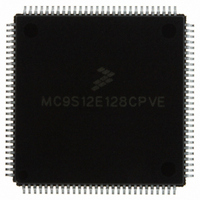MC9S12E128CPVE Freescale Semiconductor, MC9S12E128CPVE Datasheet - Page 469

MC9S12E128CPVE
Manufacturer Part Number
MC9S12E128CPVE
Description
IC MCU 128K FLASH 25MHZ 112-LQFP
Manufacturer
Freescale Semiconductor
Series
HCS12r
Specifications of MC9S12E128CPVE
Core Processor
HCS12
Core Size
16-Bit
Speed
25MHz
Connectivity
EBI/EMI, I²C, SCI, SPI
Peripherals
POR, PWM, WDT
Number Of I /o
91
Program Memory Size
128KB (128K x 8)
Program Memory Type
FLASH
Ram Size
8K x 8
Voltage - Supply (vcc/vdd)
2.35 V ~ 2.75 V
Data Converters
A/D 16x10b; D/A 2x8b
Oscillator Type
Internal
Operating Temperature
-40°C ~ 85°C
Package / Case
112-LQFP
Processor Series
S12E
Core
HCS12
Data Bus Width
16 bit
Data Ram Size
8 KB
Interface Type
SCI/SPI
Maximum Clock Frequency
25 MHz
Number Of Programmable I/os
92
Number Of Timers
12
Operating Supply Voltage
3.135 V to 5.5 V
Maximum Operating Temperature
+ 85 C
Mounting Style
SMD/SMT
3rd Party Development Tools
EWHCS12
Minimum Operating Temperature
- 40 C
On-chip Adc
16-ch x 10-bit
On-chip Dac
2-ch x 8-bit
Controller Family/series
HCS12/S12X
No. Of I/o's
90
Ram Memory Size
8KB
Cpu Speed
25MHz
No. Of Timers
4
Embedded Interface Type
I2C, SCI, SPI
Rohs Compliant
Yes
For Use With
M68EVB912E128 - BOARD EVAL FOR MC9S12E128/64
Lead Free Status / RoHS Status
Lead free / RoHS Compliant
Eeprom Size
-
Lead Free Status / Rohs Status
Lead free / RoHS Compliant
Available stocks
Company
Part Number
Manufacturer
Quantity
Price
Company:
Part Number:
MC9S12E128CPVE
Manufacturer:
Freescale Semiconductor
Quantity:
10 000
- Current page: 469 of 606
- Download datasheet (4Mb)
15.4.9
The SYNC command is unlike other BDM commands because the host does not necessarily know the
correct communication speed to use for BDM communications until after it has analyzed the response to
the SYNC command. To issue a SYNC command, the host should perform the following steps:
Upon detecting the SYNC request from the host, the target performs the following steps:
The host measures the low time of this 128 cycle SYNC response pulse and determines the correct speed
for subsequent BDM communications. Typically, the host can determine the correct communication speed
within a few percent of the actual target speed and the communication protocol can easily tolerate speed
errors of several percent.
As soon as the SYNC request is detected by the target, any partially received command or bit retrieved is
discarded. This is referred to as a soft-reset, equivalent to a time-out in the serial communication. After the
SYNC response, the target will consider the next falling edge (issued by the host) as the start of a new
BDM command or the start of new SYNC request.
Another use of the SYNC command pulse is to abort a pending ACK pulse. The behavior is exactly the
same as in a regular SYNC command. Note that one of the possible causes for a command to not be
acknowledged by the target is a host-target synchronization problem. In this case, the command may not
have been understood by the target and so an ACK response pulse will not be issued.
15.4.10 Instruction Tracing
When a TRACE1 command is issued to the BDM in active BDM, the CPU exits the standard BDM
firmware and executes a single instruction in the user code. As soon as this has occurred, the CPU is forced
to return to the standard BDM firmware and the BDM is active and ready to receive a new command. If
the TRACE1 command is issued again, the next user instruction will be executed. This facilitates stepping
or tracing through the user code one instruction at a time.
Freescale Semiconductor
1. Drive the BKGD pin low for at least 128 cycles at the lowest possible BDM serial communication
2. Drive BKGD high for a brief speedup pulse to get a fast rise time (this speedup pulse is typically
3. Remove all drive to the BKGD pin so it reverts to high impedance.
4. Listen to the BKGD pin for the sync response pulse.
1. Discards any incomplete command received or bit retrieved.
2. Waits for BKGD to return to a logic 1.
3. Delays 16 cycles to allow the host to stop driving the high speedup pulse.
4. Drives BKGD low for 128 cycles at the current BDM serial communication frequency.
5. Drives a one-cycle high speedup pulse to force a fast rise time on BKGD.
6. Removes all drive to the BKGD pin so it reverts to high impedance.
frequency (the lowest serial communication frequency is determined by the crystal oscillator or the
clock chosen by CLKSW.)
one cycle of the host clock.)
SYNC — Request Timed Reference Pulse
MC9S12E128 Data Sheet, Rev. 1.07
Chapter 15 Background Debug Module (BDMV4)
469
Related parts for MC9S12E128CPVE
Image
Part Number
Description
Manufacturer
Datasheet
Request
R
Part Number:
Description:
Manufacturer:
Freescale Semiconductor, Inc
Datasheet:
Part Number:
Description:
Manufacturer:
Freescale Semiconductor, Inc
Datasheet:
Part Number:
Description:
Manufacturer:
Freescale Semiconductor, Inc
Datasheet:
Part Number:
Description:
Manufacturer:
Freescale Semiconductor, Inc
Datasheet:
Part Number:
Description:
Manufacturer:
Freescale Semiconductor, Inc
Datasheet:
Part Number:
Description:
Manufacturer:
Freescale Semiconductor, Inc
Datasheet:
Part Number:
Description:
Manufacturer:
Freescale Semiconductor, Inc
Datasheet:
Part Number:
Description:
Manufacturer:
Freescale Semiconductor, Inc
Datasheet:
Part Number:
Description:
Manufacturer:
Freescale Semiconductor, Inc
Datasheet:
Part Number:
Description:
Manufacturer:
Freescale Semiconductor, Inc
Datasheet:
Part Number:
Description:
Manufacturer:
Freescale Semiconductor, Inc
Datasheet:
Part Number:
Description:
Manufacturer:
Freescale Semiconductor, Inc
Datasheet:
Part Number:
Description:
Manufacturer:
Freescale Semiconductor, Inc
Datasheet:
Part Number:
Description:
Manufacturer:
Freescale Semiconductor, Inc
Datasheet:
Part Number:
Description:
Manufacturer:
Freescale Semiconductor, Inc
Datasheet:











